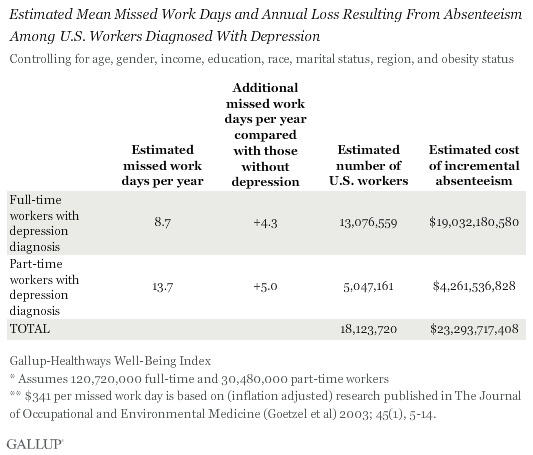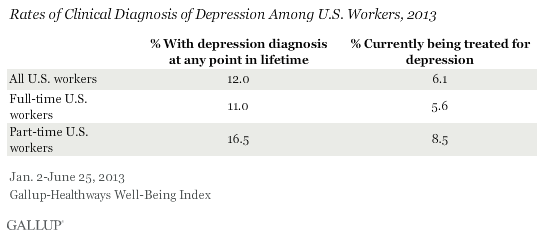WASHINGTON, D.C. -- Workers in the U.S. who, at some point in their lives, have been diagnosed with depression miss an estimated 68 million additional days of work each year than their counterparts who have not been depressed -- resulting in an estimated cost of more than $23 billion in lost productivity annually to U.S. employers.

These findings are based on Gallup-Healthways Well-Being Index data collected between Jan. 2 2011 and Dec. 30, 2012. Gallup surveyed 237,615 full-time employees (those who work at least 30 hours per week) and 66,010 part-time employees during this time period.
To measure depression, the Gallup-Healthways Well-Being Index asks respondents: "Has a doctor or nurse ever told you that you are depressed?" This analysis includes all respondents who say they have ever been diagnosed with depression, even if they are not currently being treated for depression.
Gallup calculated unhealthy days using respondents' answers to the question, "During the past 30 days, for about how many days did poor health keep you from doing your usual activities?" To estimate how unhealthy days per month translate into missed work days, Gallup asked workers this question: "Earlier, you indicated that you had xx days in the last month where poor health prevented you from doing your usual activities. How many actual work days in the last month did you not work due to poor health?"
Full-time workers who have been diagnosed with depression make up make up 10.8% of the U.S. full-time workforce and average 8.7 missed work days each year due to poor health. Workers who have never been diagnosed with depression miss an average of 4.6 work days per year. Thus, those who have depression or a history of depression miss more than four additional days per year as a function of poor health, after controlling for age, gender, income, education, race/ethnicity, region, marital status, and obesity classification.
Part-time workers are more likely to report having ever been diagnosed with depression, at 16.6%, and miss an average of 13.7 work days per year due to poor health. This compares to 8.7 missed days per year among part-time workers who have never been depressed.
In 2013 thus far, Gallup finds an average 12% of all workers nationwide saying they have been diagnosed with depression at some point in their lifetime, and about half of those who have been (representing 6.1% of all U.S. workers) are currently being treated for depression.

Implications
As U.S. employers move more aggressively to positively affect change around the physical well-being of some of their employees, such interventions may be inadequate to address the mental, emotional, and psychological health of others. Nationally, one in eight U.S. workers have been diagnosed with depression, yielding tens of millions in the workforce who have either grappled with emotional health issues in the past or do so today. Furthermore, the cost of absenteeism estimates shown in this analysis exclude other potential economic costs associated with depression, including productivity loss while on the job, healthcare utilization, workers' compensation, and turnover, among others.
For leaders of organizations, proven strategies for improving the mental health of employees generally involve the allocation of resources for early identification and treatment, employee assistance programs, efforts to culturally de-stigmatize depression and its treatment in the workplace, and management education for addressing depression and its causes.
One less obvious, but potentially fruitful strategy for employers to help improve the mental well-being among some employees with depression or depressive symptoms is engaging them through the fulfillment of certain critical psychological needs in the workplace. Engaged employees demonstrate an elevated willingness to participate in workplace well-being programs and boast elevated physical and emotional health when compared with those who are disengaged. Engaged employees also have a better mood during the workweek and do not experience increased stress from prolonged commute times.
About the Gallup-Healthways Well-Being Index
The Gallup-Healthways Well-Being Index tracks well-being in the U.S. and provides best-in-class solutions for a healthier world. To learn more, please visit well-beingindex.com.
Survey Methods
Results of the absenteeism analysis are based on telephone interviews conducted as part of the Gallup-Healthways Well-Being Index survey Jan. 2, 2011-Dec. 30, 2012, with a random sample of 303,625 national working adults, aged 18 and older, living in all 50 U.S. states and the District of Columbia, selected over both landline and cell, English and Spanish. Of these, 237,615 were working full-time and 66,010 were working part-time at the time of the interview. For results based on these samples of national working adults, one can say with 95% confidence that the maximum margin of sampling error is ±0.2 percentage points for the full-time workers and ±0.3 percentage points for the part-time workers.
Results on the current state of depression among U.S. workers were based on interviews conducted between Jan. 2-June 25, 2013, with a random sample of 42,594 national working adults. Of these, 35,440 were working full-time at the time of the interview, while 7,154 were working part-time at the time of the interview. For results based on these samples of national working adults, one can say with 95% confidence that the maximum margin of sampling error is ±0.4 percentage points for the full-time workers and ±0.9 percentage points for the part-time workers.
Interviews are conducted with respondents on landline telephones and cellular phones, with interviews conducted in Spanish for respondents who are primarily Spanish-speaking. Each sample from 2011-2012 includes a minimum quota of 400 cell phone respondents and 600 landline respondents per 1,000 national adults, with additional minimum quotas among landline respondents by region. Landline telephone numbers are chosen at random among listed telephone numbers. Cell phone numbers are selected using random-digit-dial methods. Landline respondents are chosen at random within each household on the basis of which member had the most recent birthday. Each sample from 2013 includes a minimum quota of 250 cell phone respondents and 250 landline respondents per 500 national adults interviewed daily.
Samples are weighted by gender, age, race, Hispanic ethnicity, education, region, adults in the household, and phone status (cell phone only/landline only/both, cell phone mostly, and having an unlisted landline number). Demographic weighting targets are based on the March 2011 Current Population Survey figures for the aged 18 and older non-institutionalized population living in U.S. telephone households. All reported margins of sampling error include the computed design effects for weighting and sample design.
In addition to sampling error, question wording and practical difficulties in conducting surveys can introduce error or bias into the findings of public opinion polls.
For more details on Gallup's polling methodology, visit www.gallup.com.
